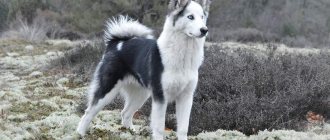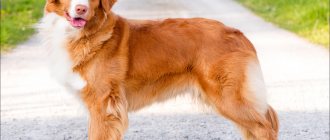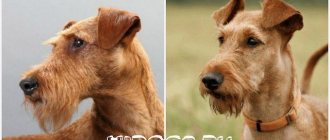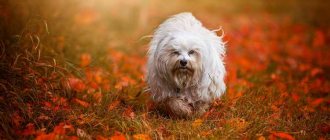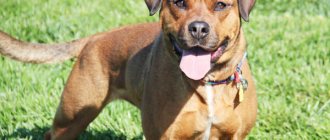Origin story
At the end of the 19th century, the settlement of Siberia began. Local residents gradually disappeared, and their dogs, purebred huskies, crossed with each other. In 1930, in the remote areas of Komi, there were huskies, but they were not hunters; they were kept on a chain like ordinary watchdogs. A heavy blow was the siege of Leningrad, during which there were no animals left. This could be the end of the breed's history.
The capital's hunters feared that the breed was on the verge of extinction, so they bought all possible huskies from all regions of the country. Their appearance was similar, with the exception of minor differences (length of the muzzle, size of the ears, etc.).
In 1944, the restoration of the breed began. The dog Putik became the ideal to follow; he was bred from a West Siberian female and a black-and-white male with excellent working qualities and conformation. In 1960, most representatives of the Russian-European Laika were black and white, which corresponds to the standard.
How to choose a puppy and how much it costs
You should choose a puppy based on the qualities of its parents, which they showed while hunting or protecting the house.
Such information about owners and their helpers can be obtained from an animal lovers club, on thematic forums or in nurseries. At 1.5 - 2 months, the puppy can already be tested to ensure it meets the necessary standards.
If you choose a Russian-European Laika puppy from a litter, you can listen to the advice of the owner, other experienced Laika lovers and your intuition.
The average cost of a Russian-European Laika is 25,000 – 30,000 rubles. The price varies depending on the working qualities of the puppy's parents.
Thus, to summarize, you can and even need to have a Russian-European Laika, a reliable and loyal friend, if you live in a private house or in an area where there are not many inhabitants, if you love hunting and are an active person in life, are ready to pay due attention to their dog, its upbringing and regular walks with games.
You should not get a Laika if you have a fairly passive lifestyle, are unable to devote enough time to raising your dog, or have a weak character. Such dogs listen only to the opinions of those whom they consider stronger than themselves, and do not bark or bite for no reason.
Description of the breed
The dogs are medium in size. Height at the withers for males is 52-58 cm, for females - 48-54 cm, weight 18-23 kg. The physique is muscular and strong. The body is slightly elongated. Paws are straight, parallel. The tail is wrapped in a ring, located at the hip or thrown over the back.
The head is wide, the muzzle is triangular, the skull is wolf-like. An elongated muzzle, too small or large eyes, and a long tail are considered a fault. The eyes are brown, regardless of color, set askew, medium-sized. The transition from forehead to muzzle is smooth. The ears are medium, triangular, abundantly covered with hair.
Colors and coat
The coat is coarse, thick, straight. The undercoat is soft. There is a voluminous collar on the neck, withers and shoulders. The hair is shorter on the head, ears and paws, and there are pants on the hind legs. Color black and piebald or black and white. The breed standard allows black color with a white spot or vice versa. The ratio of white to black is 9:1 or 6:4. At birth, puppies are almost white, but they gradually turn black. It is believed that a white dog is more suitable for hunting, and a black one for the city (since there is more dirt in the city).
Character
The dog is smart, strongly attached to the family and all its members. Loyal to her owner all her life. If a dog is taken from another owner, it may run away.
In relation to strangers, he behaves warily and distantly. He drives away strangers from his territory with a loud bark and behaves like a guard. Can get along with other dogs if they are kept together from an early age. It can get into fights with other dogs, and a struggle for leadership begins.
Russian-European Laikas are strong, agile and brave. The hunting instinct is so developed that they constantly chase cats, so early socialization is necessary.
Shepherd huskies
Representatives of this group trace their ancestry back to Nenets Laikas. These are small, light and compact dogs. The height at the withers is about 45 cm for males and 40 cm for females. To protect them from the harsh northern climate, they are given long, warm wool. The skull is wide, the forehead is moderately convex with a clear transition to the muzzle. The muzzle itself is shorter than the skull, the cheekbones are dry, tightly covered with skin. This subgroup is most optimal for shepherd service and is an excellent assistant to shepherds. Despite the fact that the husky is small, it has proven itself excellent in hunting waterfowl, wild birds, squirrels and, surprisingly, bears.
These dogs have a square body, triangular ears, strong paws and brown eyes. This type of husky is endowed with a short fluffy tail, curled into a half ring. The muzzle of such dogs is decorated with whiskers, the chest and neck visually represent a collar with a frill. The front and hind legs have breeches and feathers. The long and dense coat on the lower part of the paws makes them larger, which allows this type of husky to easily move across endless snowy expanses without falling into the snow. A coat of eight centimeters protects dogs from high frosts down to minus fifty degrees, and from forty-degree heat, as well as from annoying gnats and midges. Due to such a thickness of wool, they are not even in danger of being burned when they come into contact with a hot stove.
Shepherd huskies have different colors: black, gray. You can also find representatives of the breed that are brown with splashes of white. This type of huskies has an amazing sense of smell, which allows them to warn shepherds in advance of approaching danger. These dogs are gentle, have a lively and active character, are very sociable, but they show distrust of strangers. Very self-possessed and psychologically stable. They cope well with herding functions and have good hunting skills. Their characteristic qualities include courage, resourcefulness, and balance.
Care and maintenance
It is best to keep the Russian-European Laika in a country house or private house. But its small size allows you to have such a dog in your apartment. At the same time, he needs to be walked regularly and for a long time. It is advisable to take the dog to the forest or park, where you can let it off the leash and let it run freely. After walking through the forest, the animal is examined for the presence of ticks.
In a private or country house, it is recommended to install an aviary with a booth inside. In this case, the dog is allowed to run once every 3 days. The size of the kennel for a husky is determined taking into account the size of the dog. The height of the kennel should be 5 cm below head level so that the pet tilts its head slightly when entering. The length is equal to the size from the nose to the tip of the tail. The width is determined by measuring the dog curled up (+ 5 cm). The material for the booth should be wood.
Caring for a husky is easy. The coat needs to be combed three times a week; during shedding, this is done daily. Bath if absolutely necessary. To speed up shedding, the dog is bathed with universal shampoo (or for deep cleaning) and dried thoroughly. It is not recommended to cut your pet's hair.
The pet's ears are examined. If they are clean, they are not wiped; if there are sulfur masses or dirt, they are removed with a damp cotton pad. The eyes are washed weekly with chamomile infusion or tea leaves. Until they dry, the dog is not allowed to walk. Teeth are brushed twice a week with a special paste and brush (or attachment). Otherwise, tartar develops. After a walk, you need to check the paws: if there are cuts or scratches, they are treated. Once a month, the claws are trimmed with a nail clipper.
Feeding
The dog's health depends on proper feeding. Choose between dry food and natural food. An adult dog is fed twice a day, portions depend on weight and activity. In addition, during the cold season it is recommended to slightly increase the portion.
With a natural diet, 70% of the daily diet consists of fish and meat (calculate 10-20 g per 1 kg of pet weight) - this is how to feed correctly. There is an opinion that you should not give raw meat, since the dog can become infected with worms. In any case, the dog is given anthelmintic drugs. Bones and cartilage are not removed from fish and meat (with the exception of small fish bones). This helps maintain healthy teeth. Be sure to give a vitamin-mineral complex selected by a veterinarian, fermented milk products, and fish oil.
Prohibited foods include sweets, smoked foods and spicy foods. Dry food is not recommended; it can be used as a reward for training.
Training and education
Since the breed is a hunting breed, it is independent and prone to disobedience. When training, it is important to be a strict but fair owner. The Russian-European Laika needs early socialization, otherwise the dog may become unsociable. Raising a puppy begins from the first day it arrives in its new home. He needs to be surrounded with care, since the baby has experienced stress (has been separated from his mother).
If the main thing for the owner is hunting, it is recommended to undergo special training with field tests. If the owner cannot cope with training, it is better to turn to professionals.
Dogs are touchy, so you should not use physical force or rudeness, or shout. Basic commands that need to be taught to your dog:
- nearby - taught from 6 months of age;
- sit - after mastering the previous command;
- presentation of the subject - taught at 5-6 months;
- swimming - at six months the puppy is accustomed to water. At the same time, it is important not to force them to swim, but to interest them in getting into the water.
For a correctly executed command (positive result), the pet should be praised and treated with a treat - this way the command is better reinforced.
Samoyed husky
Another very popular dog for northern climates is the Samoyed . The breed is characterized by many unique properties, including:
- friendliness;
- tenderness;
- devotion;
- endurance;
- graceful appearance;
Samoyed huskies can become excellent family pets and companions who conscientiously carry out their tasks and protect the family from any dangers.
Such playful dogs have a large reserve of enthusiasm and playfulness . It doesn’t take them much time to find a common language with the new owner. Despite their loud barking, which, as a rule, they only make when necessary, Samoyeds are especially trusting and friendly. Therefore, they are used extremely rarely as security guards.
It is no secret that the Samoyed loves to spend a lot of time with his owner and his entourage, being in the thick of things. Lack of attention will make the dog bored, so if you do not intend to spend a lot of time with your pet, it is better not to buy such a breed.
In addition, Samoyed Huskies are prone to anxiety, which manifests itself in fear of separation. Leaving them alone for long periods of time can cause them to develop behavioral problems.
Samoyeds have always been famous for their sharp mind and excellent ability to learn . However, some dogs are independent and stubborn, so you need to have a firm and confident attitude towards them. Such huskies are suitable for those people who already have experience in keeping and training dogs.
The animal gets along well with children and does not fight with other pets. If you want to buy a quiet, calm and balanced dog, this is not an option.
Comparison of breeds
Some breeders cannot make a choice: Russian-European or West Siberian Laika:
| Options | Russian-European Laika | West Siberian Laika |
| Dimensions | Height up to 58 cm, weight up to 23 kg | Height up to 60 cm, weight up to 22 kg |
| Color | Black and white | Gray with white |
| Communication with pets | Chases cats, fights with other dogs | Does not offend other pets, is friendly with dogs |
The Russian-European Laika and the Karelian Bear Dog have a similar description. There are some differences:
| Options | Russian-European Laika | Karelian Bear Dog |
| Dimensions | Height up to 58 cm, weight up to 23 kg | Height up to 60 cm, weight up to 23 kg |
| Tail | Medium length tail | Short tail allowed |
| Eyes | Medium size brown | Little brown ones |
Pros and cons of the breed
Advantages and disadvantages of the breed:
| pros | Minuses |
| Good health | Walks should be long |
| Easy care | Often stubborn |
| Excellent Hunter | Chases cats and other animals |
With proper upbringing, this characteristic can be corrected.

